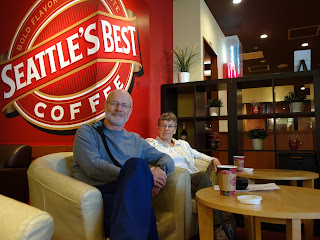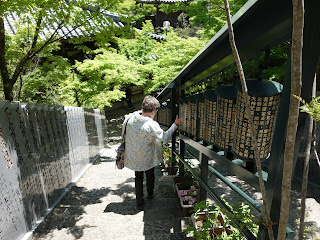It was going to be a long but hopefully an exciting day. I was about to tick off one more box on my bucket list. Ride the Bullet Train or Shinkasen as it is known in Japan. These trains can reach speeds up to 320 kilometres per hour. and run on a network of rails linking most major cities on the islands of Honshu, Kyushu and Hokkaido.
We were off to Hiroshima as well as the small island of Miyajima, a distance of just over 300 kilometres from Kobe. Travel time is a short 90 minutes. One small glitch. Bullet trains do not pass through Kobe so we had to take slower commuter train to another station which added 15 minutes to the trip. Arriving, we discovered the commuter station was not the Shinkasen station but thanks to two young Japanese men dressed like pilots, who led us to the Shinkasen station. We assumed they were pilots/engineers for one of the Shinkasen trains.
We arrived early and were rewarded with cups of Seattle's Best before catching the Bullet. We had been making do with instant coffee in our hotel as the local Starbucks in Kobe was never open before we left on our daily adventures. I had to hike down three stories to a large potable hot water dispenser, fill two cups with hot water and return to the room without spilling. A pretty glorious feat, first thing in the morning for a 65 year old.
The train lived up to it's reputation. Clean and fast. Arriving on time to Hiroshima Station where we boarded a local train that would take us to the ferry for Miyajima Island. Yes, another ferry.
Thankfully a short, 10 minute trip. Not long enough for Nonie to start to panic. It was very full however which had her counting life jackets and planning escape routes.
The national holiday had started and Japanese tourists were out in hordes. Anticipating a long wait to board, we were disappointed when the crew fully emptied and loaded the ferry in under 5 minutes. The Japanese know how to deal with hordes.
Miyajima also known as Isukushima is a small island in Hiroshima Bay about 30 minutes outside Hiroshima. It is known for its forests and ancient temples and is one of the top three scenic spots of Japan.
The giant, orange Grand Torii Gate partially submerged at high tide marks the entrance to the Itsukushima Shrine. We arrived at low tide and were able to walk out to the gate.
There was a 90 minute wait to get into the Shrine so we opted to view it from the tidal flats
and avoid the hordes.
Next, we hiked up to the Daisho-in Temple located about 1/2 way up Mount Misen.
The temple is one of the most important temples of Shingon Buddhism, one of the major schools of Buddhism. As we discovered, Buddha comes in many shapes
and sizes.
The Island is home to a herd of about 1200 Sika Deer. At one point, they were worshipped by the locals. After WWII, the deer were struggling to survive, so the islanders offered them food. Over time they became citified and a major tourist attraction. Tourists by the thousands would come to the island to feed the tame deer with rice crackers sold by local vendors.
The now, well fed deer flourished, causing a huge surge in their numbers. This led to deer poop everywhere, vehicular / deer interactions and deer fences due to depletion of the wild and planted vegetation found on the island. In 2008, the city put up "Do Not Feed the Deer" signs, hoping that as the deer got hungry, the would move out and return to wild.
Not so, the signs are ignored by many and the ravenous deer will eat anything. Maps, brochures, plastic bags. Don't leave your picnic basket unguarded.
Time to head to Hiroshima.
Not so, the signs are ignored by many and the ravenous deer will eat anything. Maps, brochures, plastic bags. Don't leave your picnic basket unguarded.
Time to head to Hiroshima.

















No comments:
Post a Comment